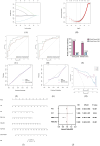A nomogram model based on tumor necrosis factor-like ligand 1A(TL1A) and death receptor-3(DR3) promoter methylation for predicting 90-day prognosis in patients with HBV-associated acute-on-chronic liver failure
- PMID: 40678004
- PMCID: PMC12267024
- DOI: 10.3389/fmolb.2025.1614311
A nomogram model based on tumor necrosis factor-like ligand 1A(TL1A) and death receptor-3(DR3) promoter methylation for predicting 90-day prognosis in patients with HBV-associated acute-on-chronic liver failure
Abstract
Purpose: Acute-on-chronic liver failure (ACLF) associated with hepatitis-B-virus (HBV) is a life-threatening condition characterized by severe hepatic dysfunction. The TL1A/DR3 signaling axis modulates immune responses and contributes to hepatic inflammation. This study aimed to investigate the methylation level of TL1A/DR3 promoter, explore its ability to predict prognosis, and establish a prognostic model combined with clinical indicators.
Method: Methylation status and gene expression of TL1A and DR3 were analyzed in peripheral blood mononuclear cells (PBMCs) from 714 participants using Methylight and quantitative polymerase chain reaction (qPCR). Univariate, LASSO, and multivariate analyses were performed to identify key prognostic factors for 90-day outcomes in patients with HBV-associated acute-on-chronic liver failure (HBV-ACLF) and develop corresponding prognostic models. Model performance, including calibration and clinical utility, was evaluated using receiver operating characteristic (ROC) curves, Hosmer-Lemeshow (H-L) tests, and decision curve analysis (DCA). A visual nomogram was constructed to integrate these factors for risk stratification.
Result: Analysis revealed significantly reduced TL1A and DR3 promoter methylation in HBV-ACLF patients, correlating with impaired liver function and coagulation parameters. PBMCs from these patients showed elevated mRNA expression of TL1A, DR3 and IL-6 compared to other groups. Methylation levels of TL1A and DR3 demonstrated high sensitivity and specificity in predicting HBV-ACLF severity. Besides, non-survivors exhibited lower TL1A/DR3 methylation than survivors. A prognostic model integrating prothrombin time activity (PTA), procalcitonin (PCT), and TL1A/DR3 methylation demonstrated excellent performance in predicting 90-day outcomes.
Conclusion: Aberrant TL1A/DR3 promoter methylation reflects the disease severity, and can serve as potential biomarkers for the risk assessment of HBV-ACLF.
Keywords: HBV-ACLF; TL1A/DR3; methylation; noninvasive model; prognosis.
Copyright © 2025 Wei, Zhang, Zhu, Tian, Xu, Fan and Wang.
Conflict of interest statement
The authors declare that the research was conducted in the absence of any commercial or financial relationships that could be construed as a potential conflict of interest.
Figures






Similar articles
-
Clinical Model Based on DR3 Promoter Methylation for Predicting Short-Term Mortality in Patients with Acute-on-Chronic Hepatitis B Liver Failure.Int J Gen Med. 2025 Jun 19;18:3253-3266. doi: 10.2147/IJGM.S525424. eCollection 2025. Int J Gen Med. 2025. PMID: 40551754 Free PMC article.
-
[Predictive value of liver-to-spleen volume ratio for short-term prognosis in patients with hepatitis B virus-related acute-on-chronic liver failure].Zhonghua Yi Xue Za Zhi. 2025 Jun 24;105(24):1989-1996. doi: 10.3760/cma.j.cn112137-20250222-00424. Zhonghua Yi Xue Za Zhi. 2025. PMID: 40550644 Chinese.
-
Golgi protein 73 and IL-6 as strong predictors of short-term prognosis in patients with HBV-ACLF.Sci Rep. 2025 Jul 1;15(1):22191. doi: 10.1038/s41598-025-06472-1. Sci Rep. 2025. PMID: 40594814 Free PMC article.
-
Adefovir dipivoxil and pegylated interferon alfa-2a for the treatment of chronic hepatitis B: a systematic review and economic evaluation.Health Technol Assess. 2006 Aug;10(28):iii-iv, xi-xiv, 1-183. doi: 10.3310/hta10280. Health Technol Assess. 2006. PMID: 16904047
-
Pharmacological interventions for acute hepatitis B infection: an attempted network meta-analysis.Cochrane Database Syst Rev. 2017 Mar 21;3(3):CD011645. doi: 10.1002/14651858.CD011645.pub2. Cochrane Database Syst Rev. 2017. PMID: 28321877 Free PMC article.
References
-
- Bamias G., Stamatelopoulos K., Zampeli E., Protogerou A., Sigala F., Papamichael C., et al. (2013). Circulating levels of TNF-like cytokine 1A correlate with the progression of atheromatous lesions in patients with rheumatoid arthritis. Clin. Immunol. 147 (2), 144–150. 10.1016/j.clim.2013.03.002 - DOI - PubMed
LinkOut - more resources
Full Text Sources

